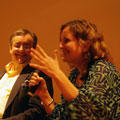Alysa Nahmias speaks with an audience member following the screening. Photo by Jennifer Prediger.
Alysa Nahmias
Alysa Nahmias is the co-director of Unfinished Spaces, a documentary about the visionary design of Cuba’s National Art Schools in the wake of Fidel Castro’s Revolution. She joined Film Forward in Puerto Rico this week to screen the film at the University of Puerto Rico Architecture School and participate in a post-screening discussion with audience members.
I’ve been told several times since I landed here in San Juan that Puerto Ricans and Cubans consider their countries to be brothers (paises hermanos). As I drove through San Juan for the first time yesterday, I could easily understand why the Puerto Rican capitol is the adopted home of the largest population of Cubans outside of Cuba. Even more than Miami or Madrid, the atmosphere (ambiente) and landscape (paisaje) of San Juan are reminiscent of Havana’s; the sea-lined streets, the Morro Fort, the brightly painted colonial buildings in Old San Juan, the white concrete tropical modernist buildings downtown, and the sounds of salsa and reggaeton filling the streets all felt familiar to me after having spent many years filming Unfinished Spaces in Cuba. I was looking forward to meeting the Puerto Ricans who would be attending the Film Forward programs and talking more about the connections and distinctions between the two paises hermanos (brother countries).
At the University of Puerto Rico Architecture School, we were welcomed by the dean, Francisco Javier Rodriguez and by the many students and filmgoers lined up to fill the auditorium. The turnout was incredible, far beyond my expectations for the Puerto Rican premiere of this film!
What struck me the most during this screening was the audience’s laughter – the Puerto Ricans connected immediately with the Cuban sense of humor of the architect-protagonists in our film’s story. They didn’t hold back their belly laughter when Ricardo Porro talked about his “papaya fountain,” designed to resemble female genitalia, and likewise they appreciated Porro’s dark humor in the face of his own mortality at the end of the story.
This audience’s laughter was contagious, and I think that this is because they also allowed themselves to feel in equal measure the story’s pain. I could sense the audience’s tears when the film recounts Cuba’s periods of extreme national turmoil. The audience members weren’t sobbing loudly, but they were experiencing along with the characters in the film the deep personal frustration with leaders gone awry and the obstacles that challenge the artistic process around the world. You could feel it in the air.
During the post-screening discussion, more personal stories emerged. A young architecture professor shared: “I left Cuba in 1995, during Cuba’s Special Period when everyone was hungry and the country’s morale was at its lowest point.”
Another young man, a visual art student, spoke up: “My grandfather came to Puerto Rico from Cuba, and I never understood what he went through until I saw this film; now I understand my grandfather.” After the screening he gave me a hug of gratitude, saying he wants to invite his grandfather to the FILM FORWARD screening tomorrow. It was extremely moving – the kind of moment you hope for as a filmmaker, when your project touches someone on a personal level and transforms his relationship with the world around him.
Later, at the cocktail party, a couple approached me, saying, “we didn’t want to say this in public, because you know how it is for us as Cubans when we expose ourselves to charged political discussions, but we wanted to tell you that we lived through the 1960s and 70s in Cuba, and it means the world to us that you’ve made this film and that this story is being shown in Puerto Rico.”
What’s more, the Puerto Rican audience members – regardless of Cuban heritage or not – connected with the story of artists who persevere in the face of obstacles. Panelist Warren James, a Puerto Rican architect, talked about the fact that the primary client for architecture in Puerto Rico is the government, so the Cuban story sounds familiar in the Puerto Rican context. I hope that this and other echoes of comparison or contrast allow the Puerto Rican audiences to explore the issues relevant to them in relation to art, politics, and identity, and that they continue to allow me to learn from their insights about these themes.




